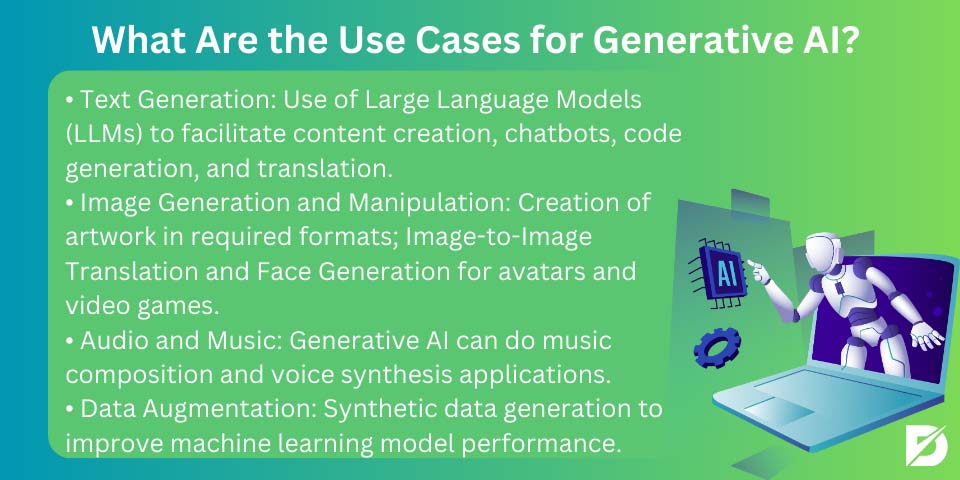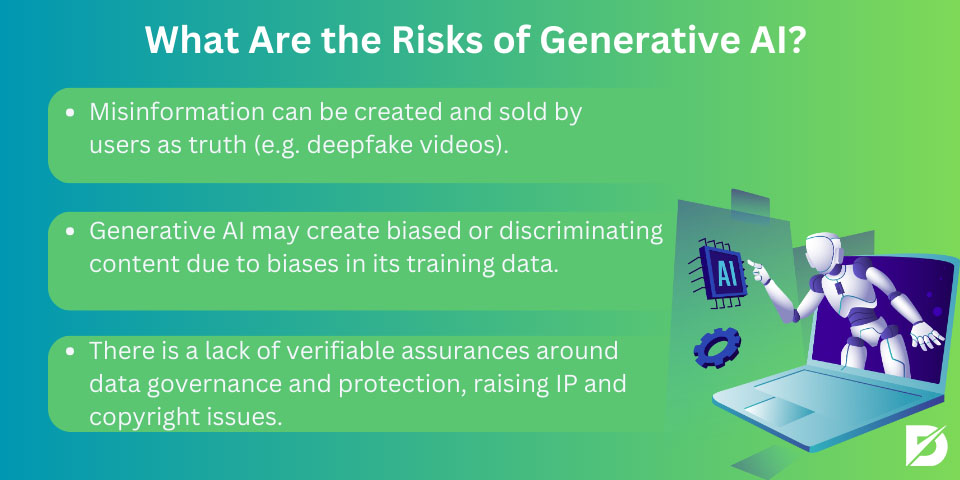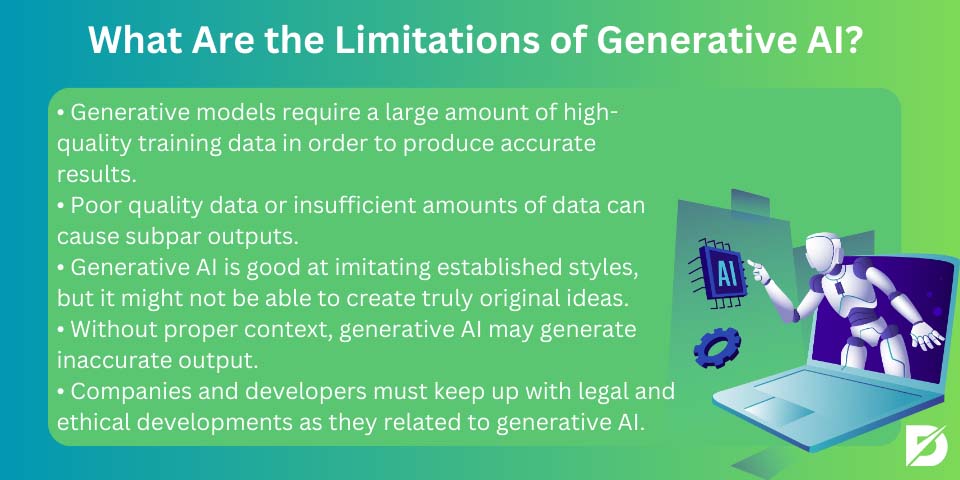ChatGPT, Google Bard, Bing Chat… We use “generative AI” to define all those tools, but you might be thinking what Generative AI is. In today’s article, we will talk about what is Generative AI, its benefits and limitations, and some cases. If you are wondering about it, first, let’s talk about the generative AI meaning.
Generative AI refers to the algorithms that can create a brand-new product, such as a text, photo, poem, essay, video, code, and so on, with the help of existing data. They basically “generate” a unique and new output by using and referring to the vast data they were trained on. On one hand, other types of artificial intelligence may be used for many objectives, such as data analysis or assisting in the control of a self-driving car. On the other hand, generative AI’s main goal is to produce inventive content for its users.
If we got the meaning, let’s delve into our article about generative AI and understand its background mechanism.
How Does Generative AI Work?
To create fresh data or material that is similar to a given dataset, generative AI trains machine learning models, often neural networks. In order to generate fresh, realistic examples that are consistent with the training data, it is necessary to simulate the underlying patterns, structures, and statistics of the data.
The training and generation procedures used by various generative AI techniques may differ. For instance, autoregressive models like RNNs and Transformers generate output one step simultaneously, conditioning each step on the previous ones. On the other hand, GANs require a two-step process with a generator network and a discriminator network that compete against each other.
It’s crucial to remember that generative Artificial Intelligence models can be extremely complicated. Training frequently necessitates a significant amount of processing power and data. The model architecture, the amount and quality of the training dataset, and the training procedure itself all affect how well the generated content turns out.
With continued study and development, generative AI is advancing in a number of fields, including picture synthesis and natural language production.
What Are the Use Cases for Generative AI?
Generative AI can be used for many industries and areas, from engineering and research to education and more. The use cases can spread various specializations and individuals. Here are some common and notable AI applications:

- Text Generation: Text is at the heart of every generative AI tool since written format is the most common one. One of the most well-known examples of text-based generative models is called large language models or LLMs. LLMs can be used for various purposes, such as content creation, chatbots, code generation, and translation.
- Image Generation and Manipulation: One of the most common ways of data manipulation for generative AI tools is image creation. They can create artwork in the required format. Moreover, Image-to-Image Translation, in which the AI tool translates one style to another, and Face Generation, which generates faces for avatars and video games, are two other applications.
- Audio and Music: Even though audio and music are relatively new for generative AI, they are emerging areas with lots of products. Generative AI can do music composition and voice synthesis for applications.
- Data Augmentation: By generating synthetic data, generative AI tools can create additional training data to improve the performance of machine learning models.
What Are the Benefits of Generative AI?
Generative AI has lots of benefits for different areas and industries. Here are some of the benefits that can intrigue you to use it applications:
- With the use of generative AI, procedures for creating content can be automated, saving time and the need for manual labor in jobs like writing, designing, and data entry. It can produce content at scale, making it suited for sectors with large content requirements, like media and e-commerce.
- By creating original ideas and concepts, generative AI can help with brainstorming and ideation. It may push the envelope of creativity and stimulate new forms of artistic expression in disciplines like art and music.
- It makes it possible to personalize information and recommendations for specific users, which enhances their engagement and pleasure.
- To supplement training datasets in machine learning, it can produce artificial data, leading to more reliable and accurate models.
- Automating repetitive operations with generative AI can eliminate the need to hire additional workers for content development. It can eliminate waste in sectors like manufacturing and supply chain management and optimize resource allocation.
What Are the Risks of Generative AI?
Even though the benefits of generative AI may be attractive, there are some risks. Currently, risks of it are on the rise and make everyone cautious about the topic itself.
The first risk is spreading misinformation. Users can create incorrect output forms and sell them as if it is the truth. For example, deepfake videos, which may be produced using it, are incredibly convincing fake content that can be used for propagandizing, impersonating, or spreading false information.

The second risk is about being biased or neutral. Some AI tools can create biased content. But why? Creating biased or discriminating content may result from generative models inheriting biases in their training data. Existing preconceptions and disparities may be strengthened by this.
The last risk you should consider is Intellectual property (IP) issues and copyrights. Regarding confidential company information, there are currently no verifiable assurances of data governance and protection. Users should anticipate that whatever information or inquiries they make into ChatGPT and its rivals will become public knowledge.
What Are the Limitations of Generative AI?
Of course, everything does not come with its beauty. Everything has its own flaws, and generative AI is one of them. Even though it has lots of benefits and eases the job we do for most of us, there are some limitations that might make you consider the choice of using generative AI in your job.

- Content that is generated might have a wide range of quality. Despite the fact that some outputs might be incredibly realistic, others might be less cohesive or contain mistakes.
- A significant amount of high-quality training data is necessary for generative models. Results can suffer from a lack of training data or data that is below the average.
- Although generative AI may imitate established styles, it may have trouble coming up with truly original and creative ideas.
- AI models may find it difficult to completely comprehend context, resulting in output that is unsuitable or inaccurate from a contextual standpoint.
- Companies and developers must manage challenging problems like responsibility and accountability as the legal and ethical landscape surrounding AI changes.
Is Generative AI Sentient?
Well, our answer is short, no. As we can tell, generative AI is not conscious. Sentience is the ability to have consciousness, self-awareness, and subjective experiences—qualities characteristic of living things, including humans and some animals. Generative AI lacks consciousness, self-awareness, emotions, and subjective experiences. This includes sophisticated models like GPT (Generative Pre-trained Transformer) and neural networks used for content generation.
While generative AI is capable of creating writing, graphics, or other stuff that resembles what a human might create, it does so without any inherent understanding or consciousness. Instead, it relies on patterns and statistical relationships in the data it was trained on. In the output of generative AI, any appearance of consciousness is solely the consequence of sophisticated pattern recognition and generation, not actual awareness or understanding.
Conclusion: Using the Potential of Generative AI
Generative AI is a significant accomplishment in the age of artificial intelligence, altering how we produce content, produce art, and interact with technology. It is clear that Generative AI is a potent tool, but not one without restrictions and ethical issues. Since we’ve dug into its inner workings, looked at its countless use cases, and balanced its advantages and drawbacks, we can see it. This technology continues to influence numerous industries, from speeding up content generation to assisting in medical development and releasing artistic creativity. However, it is still your duty to use it morally and deal with the problems it presents.
Frequently Asked Questions About
According to the many resources, Joseph Weizenbaum is the one who created the first generative AI in the 1960s as a part of the Eliza Chatbot.
Even though we say that generative AI eases the process, we cannot say that it will definitely replace you. Since it lacks the touch of humans and emotions, of course, in lots of industries, humans will be in need.
Generative AI should be used responsibly and ethically by eliminating biases, promoting transparency, confirming content’s veracity, and adhering to legal and privacy requirements.





No comments to show.